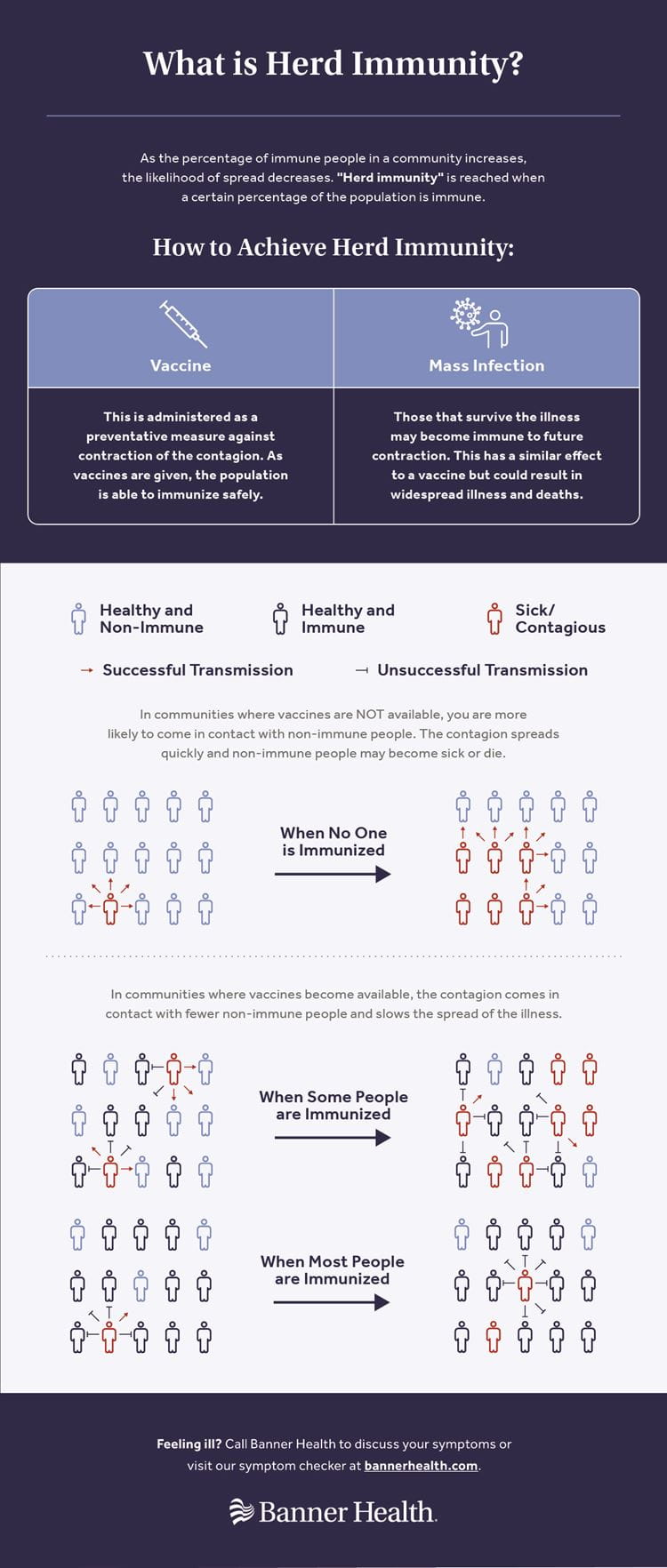The world is a big place. Which makes widespread illnesses like influenza, measles and today’s coronavirus so hard to comprehend. It’s rare to see the same challenges that we face in our hometown happening in communities hundreds, if not thousands of miles away. While disease is a complicated and nuanced issue, there is a common goal in the disintegration of all of these diseases – Herd Immunity. The question is, how do we get there?
We asked Brian Mochon, PhD, a clinical microbiologist and system medical director at Sonora Quest Laboratories/Laboratory Sciences of Arizona for infectious disease testing, to provide his insight on this important and much-debated topic.
What is herd immunity?
Herd immunity (or community immunity) occurs as a population becomes immune to a disease. By way of either a vaccine or exposure, as the percentage of immune people increases, the likelihood of a contagious person encountering and infecting a non-immune person decreases. At a certain point, the infection’s likelihood of spreading is so low, the population is considered “herd immune.” This infographic explains the idea visually:
What have we learned about herd immunity from our world history?
The world has seen more than a few pandemics and epidemics. The black death, occurring in the mid-14th century, devastated the European population and changed its history forever. In the late 19th century, the flu pandemic devastated the world at a global scale, killing more than a million people in just a few months. More recently, Swine Flu, Ebola and Zika put the world on a race to find a vaccine. Something can be learned from every infectious disease the human race has encountered.
Jonas Salk famously developed the polio vaccine in 1955. Prior to the vaccine, the disease crippled more than 35,000 people each year. Not every individual received the vaccine, but having reached the necessary threshold, the United States achieved herd immunity. As of 1979, the Centers for Disease Control and Prevention (CDC) reports no cases in the United States.
The eradication of smallpox has been widely credited as the greatest public health achievement to date. Smallpox was an extremely dangerous virus, carrying with it at least a 30% mortality rate. In 1959, the World Health Organization focused its efforts on eradicating smallpox worldwide, but it was met with challenges in funding, personnel and commitment from countries. Finally, in 1980, the world was officially declared free of smallpox.
In both cases, Dr. Mochon cited human behavior as a key element in the vaccines’ success. Distribution and acceptance of this solution is necessary to achieve herd immunity. Likewise, he noted, the opposite can be true. Herd immunity can be reversed if adoption of vaccines and other safe practices are not supported worldwide. Dr. Mochon made special note of measles – a dangerous virus that, over the last few years, has seen a spike in cases. This is an example of how important vaccine acceptance and support is, even after herd immunity has been achieved.
How difficult is it to achieve herd immunity?
In a global pandemic, this is a very difficult question to answer. Experts use a measure called the basic reproductive number, also known as R0 (pronounced R naught), to estimate how quickly a contagion is spread. This number estimates how contagious the disease is within a population. So, in other words, if you get sick, the basic reproductive number tells you how many people you will probably infect.
But I’ll just get sick and move on, right? Nope! Some diseases are more contagious than others and will continue to spread with no clear end in sight. Dr. Mochon gave an example of how the basic reproductive rate can drastically affect the level of immunization needed to create herd immunity. He explained, “in less contagious diseases, 50% of the population will need to have protective immunity to achieve herd immunity, whereas with much more contagious diseases, protective immunity will need to reach or exceed 80%.”
What risks are associated with herd immunity today?
Once a vaccine is developed, tested and proven to be effective, the only barrier left is distribution of the vaccine. However, vaccine development can take several years, and history has proven distribution to be difficult as well. Even with a vaccine, there are still many factors to be considered.
With no vaccine, there is only one possible way to achieve herd immunity – mass infection. While many could recover from the disease, allowing the virus to spread freely will come at the cost of many, many lives and even more unintended consequences. Dr. Mochon referenced Sweden’s recent actions in response to COVID-19, resisting the stricter lock-down measures of neighboring Scandinavian countries. “Data from Johns Hopkins University shows that Sweden has 39.57 deaths per 100,000 population, whereas Norway and Finland are 4.42 per 100,000 and 5.58 per 100,000, respectively.” For Sweden, their commitment to herd immunity without a vaccine has resulted in high infection rates, it has also created a greater likelihood of death.
The Swedes decided on this approach based on many factors including the geographic distribution of their elderly community, the density of their population and the overall health of their people. They are among the least obese countries in the world, with America ranking as one of the most obese. These factors show the riskiness associated with applying Swedish approaches in America. The fact is, Americans are in a worse condition to handle widespread outbreak and we have a much larger population to lose.
It’s difficult to be patient in the midst of a global pandemic. While scientists work around the clock to find a solution for COVID-19, the CDC’s guidelines for social distancing, handwashing, wearing masks and other recommended practices continue to be our best bet for slowing the spread. You aren’t alone. If you feel that you may be experiencing symptoms related to COVID-19, please call Banner Health to get tested.



